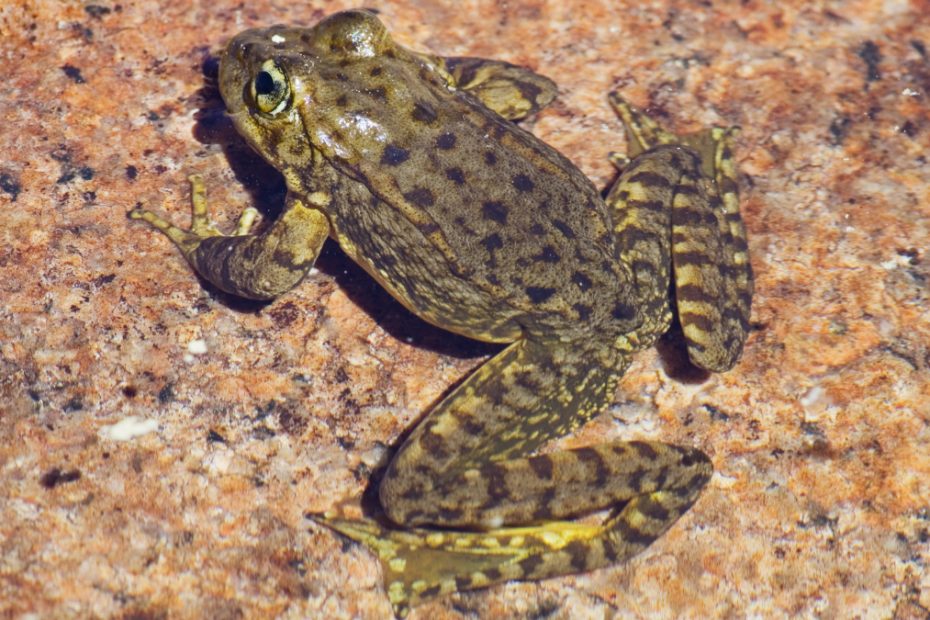Mountain Yellow-legged Frogs are unique creatures known for their distinctive yellow coloration and small size. These made them quite an interesting sight to behold.
But wait! Why should we care about these little critters? Well, it turns out that Mountain Yellow-legged Frogs play an essential role in the high-elevation ecosystems of Western North America. So, by studying and conserving their populations, we’re helping to protect these unique frogs and the balance of their entire ecosystem.
In this post, we’ll take a closer look at the Mountain Yellow-legged Frog physical characteristics that make them so unique, including their size, coloration, and vocalizations. We’ll also explore their preferred habitats and behaviors, including their activity and mating habits.
And, of course, we’ll touch on the importance of conservation efforts to protect these fascinating creatures from threats. So, keep reading till the end to learn everything about this fascinating frog species.
Scientific Classification of Mountain Yellow-Legged Frog
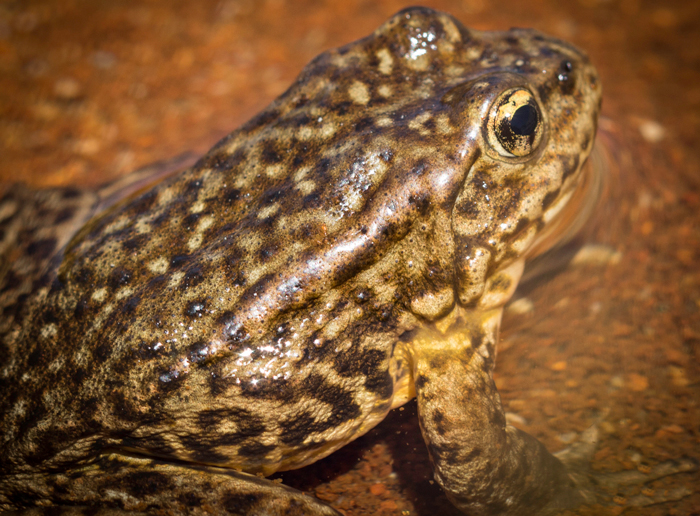
The scientific name of the Mountain Yellow-legged Frog is Rana muscosa.
However, its colloquial name is just “Yellow-legged Frog” or “Southern Yellow-legged Frog.” Following the scientific classification of the frog.
- Kingdom: Animalia
- Phylum: Chordata
- Class: Amphibia
- Order: Anura
- Family: Ranidae
- Genus: Rana
- Species: Rana muscosa
Physical Characteristics of Mountain Yellow-Legged Frog

Mountain Yellow-legged Frogs are small amphibians with distinct physical features that set them apart from other frog species.
Size:
On average, Mountain Yellow-legged Frogs measure between 1.5 and 3 inches in length. This makes them one of the smallest frog species in North America.
They are also relatively light, weighing between 4 and 10 grams.
Coloration and Markings
One of the most distinctive physical features of Mountain Yellow-legged Frogs is their bright yellow coloration. This can range from a light lemon yellow to a darker, more vibrant yellow.
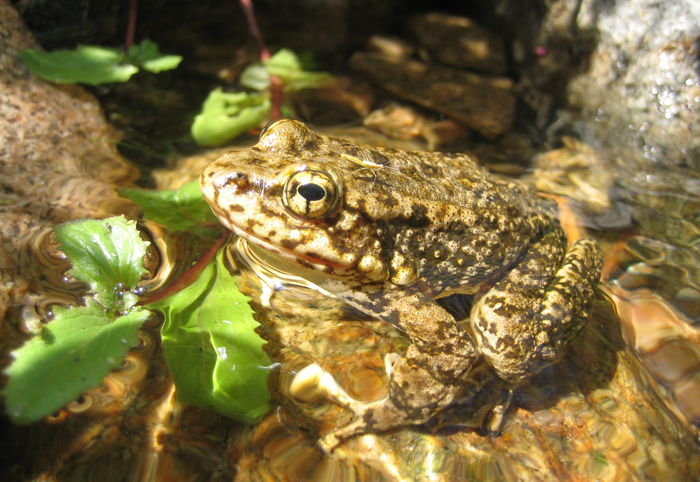
This coloration is most pronounced on their undersides, which are often a bright, buttery yellow. The rest of their bodies are typically a mottled brown or green color. This provides excellent camouflage in their natural environment.
Some individuals may have even darker spots or stripes on their bodies.
Skin Texture
The skin of Mountain Yellow-legged Frogs is generally smooth and moist. This feature helps them to breathe through their skin.
However, they also have small bumps or ridges on their skin. This characteristic can help to provide additional grip when climbing or moving through rough terrain.
Different Species:
There are 3 recognized species of Mountain Yellow-legged Frogs found in Western North America. Such as:
- The Sierra Nevada Yellow-legged Frog (Rana sierrae):
- The Southern Mountain Yellow-legged Frog (Rana muscosa):
- Foothill yellow-legged frog (Rana boylii):

Each Mountain Yellow-legged Frog species has slightly different physical characteristics. They also can be found in specific regions of the western United States.
Here’s a table comparing the physical characteristics of the different Mountain Yellow-legged Frog species:
| Species | Size (length) | Coloration and Markings | Skin Texture |
|---|---|---|---|
| Sierra Nevada | 2-3 inches (5-8 cm) | Bright yellow on the underside and legs | Rough and warty |
| Southern California | 1.5-2.5 inches (4-6 cm) | Light yellow or olive brown on the underside | Smooth and slimy |
| Northern California | 1.5-2 inches (4-5 cm) | Yellow or light brown on the underside | Rough and warty |
Adaptation Abilities
Mountain Yellow-legged Frogs have a number of adaptations that allow them to survive in their high-elevation habitats. In highly elevated landscapes, the winter tends to be much harsher and colder. The amount of prey also plummets for these frogs.
Thus, one of the most impressive tactics of adaptation by these frogs is their ability to hibernate during the winter months when temperatures can drop below freezing.
During hibernation, the frogs reduce their metabolic and heart rates and essentially shut down their bodies until spring arrives. This allows them to conserve energy and avoid freezing to death.
Mountain Yellow-legged Frog Habitat And Behavior

Both Mountain Yellow-legged Frog behavior and their habitat are unique from other frog species.
Geographical Distribution
Mountain Yellow-legged Frogs are native to Western North America. Specifically the areas of the Sierra Nevada Mountains, Southern California, and the San Gabriel Mountains.
Plus they are also found in isolated populations in the San Bernardino Mountains and the San Jacinto Mountains in California.
Preferred Environment
Mountain Yellow-legged Frogs prefer to live near ponds, lakes, and streams, especially in areas with open canopy forests and meadows. They are also found in rocky areas and grasslands.
Simply, these frogs are dependent on clean, clear, and cold water for their survival.
Elevation Range
Mountain Yellow-legged Frogs can be found at elevations ranging from 1,500 feet to 14,000 feet. But, they are most commonly found at elevations between 4,500 and 12,000 feet.
Activity Patterns
Mountain Yellow-legged Frogs are primarily nocturnal, meaning they are most active during the night. During the day, they can be found resting in cool, damp places such as under rocks or logs.
Not only that, but they are also capable of hopping on land and swimming in water. But, they are not able to climb trees or other structures. They are also solitary creatures and generally do not form groups or communities.
Communication
Mountain Yellow-legged Frogs use vocalizations to communicate with each other during the breeding season.
To be more specific, males produce a series of calls that are used to attract females and establish territorial boundaries. These calls can be heard from a distance of up to 100 feet away.

In addition to vocalizations, Mountain Yellow-legged Frogs also communicate with each other through body language and chemical signals. They use a range of visual cues to express their intentions, such as head bobbing, arm waving, and foot flicking.
These frog behaviors are especially important during aggressive encounters between males competing for a mate or territory.
For example, when two males meet, they may display a series of aggressive behaviors, including puffing up their bodies, lunging at each other, and making threatening calls.
They also use chemical cues to locate potential mates, establish territory boundaries, and detect predators. Males and females emit different chemical signals during the breeding season, which can be detected by other individuals in the area.
Predators and Defense Mechanisms
Mountain Yellow-legged Frogs have a number of natural predators in their habitat. They include birds, reptiles, and mammals such as raccoons, minks, and otters.
To defend themselves against predators, these frogs have developed a range of defense mechanisms. One such mechanism is their ability to blend in with their surroundings using their natural camouflage. This helps them to avoid detection by predators.
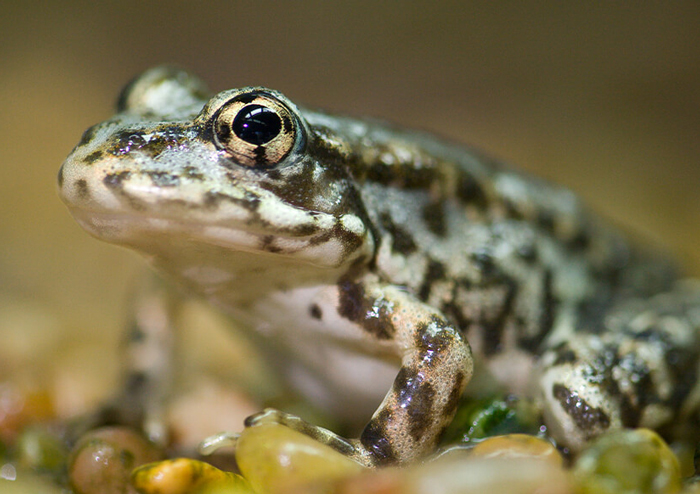
They also can jump and swim quickly, which allows them to escape from danger when needed.
Another important defense mechanism is their skin secretions, which can be toxic to potential predators. These secretions contain a variety of chemical compounds, including poisonous alkaloids and peptides.
In addition, Mountain Yellow-legged Frogs can puff themselves up to make themselves appear larger and more intimidating to predators.
Mating Habits and Breeding Behaviors
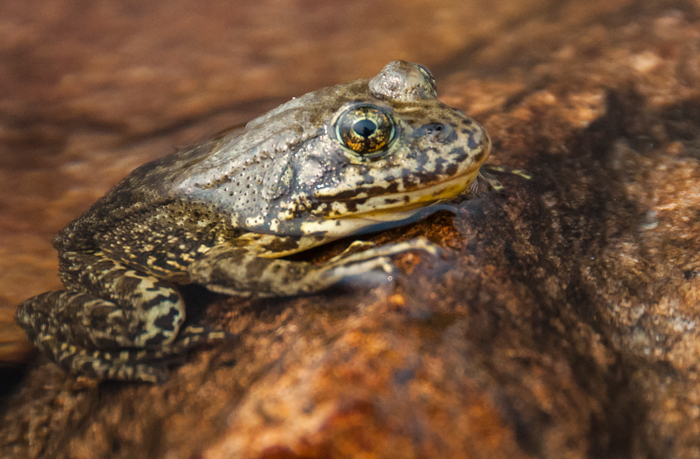
Mountain Yellow-legged Frogs have an extended breeding season that typically runs from late spring to early summer. During this time, males establish territories near water sources and attract females through their calls.
- Mating Season: These frogs usually mate between May and July.
- Mating Rituals: Males attract females through vocalizations, including calls and trills. They will also display by extending their legs and puffing out their vocal sacs.
This behavior serves to establish dominance over other males and to attract females. When a female is receptive, she will approach a male, and the two will enter into amplexus, with the male gripping the female tightly around the waist.
- Fertilization Type: Mountain Yellow-legged Frogs have “external fertilization”. This means that eggs are fertilized outside the female’s body, usually in water.
Specifically, the females lay eggs in the water, and the male then releases sperm over the eggs to fertilize them externally. The fertilized eggs develop into tadpoles that eventually metamorphose into adult frogs.
- Egg-Laying Habits: Females typically lay between 400 and 1,000 eggs in clusters attached to submerged vegetation or rocks.
- Development Stages: The eggs of Mountain Yellow-legged Frogs typically hatch within one to two weeks. The tadpoles then undergo “metamorphosis”, a process that takes between two and four months.
Once the tadpoles have transformed into frogs, they leave the water and join the terrestrial population.
- Parental Care: Mountain Yellow-legged Frogs do not provide any parental care once they have laid their eggs.
Dietary Habits of Mountain Yellow-Legged Frogs
Mountain Yellow-legged Frogs are primarily carnivores and primarily feed on a variety of insects and other small invertebrates.
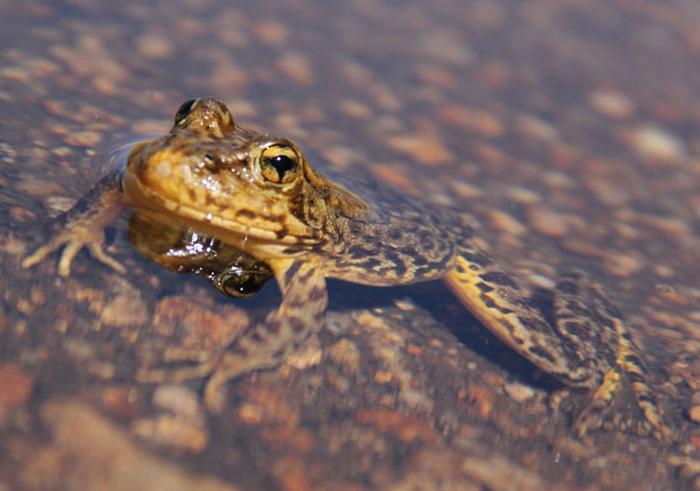
Some of their common prey include ants, spiders, beetles, and flies. They have been observed to consume prey that is up to 60% of their own body size, which is quite impressive considering their small size.
Foraging Strategies
Mountain Yellow-legged Frogs use different foraging strategies to capture their prey. They often sit and wait for their prey to come near, then lunge at it with sticky tongues. Plus, they can also actively hunt by stalking and chasing their prey.
Opportunistic Feeding Habits:
Mountain Yellow-legged Frogs are opportunistic feeders, meaning that they will eat whatever is available in their habitat.
But, generally, these frogs mainly eat algae, aquatic and land-based insects. Moreover, they can switch their diet according to the abundance and availability of prey.
For example, when the number of algae and aquatic insects is abundant, these frogs can overeat and store excess fat reserves in their bodies.
On the contrary, they will feed on other small amphibians and fish and even cannibalize their own tadpoles when food is scarce.
Conservation Status
The Mountain Yellow-legged Frogs face numerous threats that have caused its population to decline drastically over the past few decades. In 2021, the IUCN Red List of Threatened Species listed the species as “Endangered”.
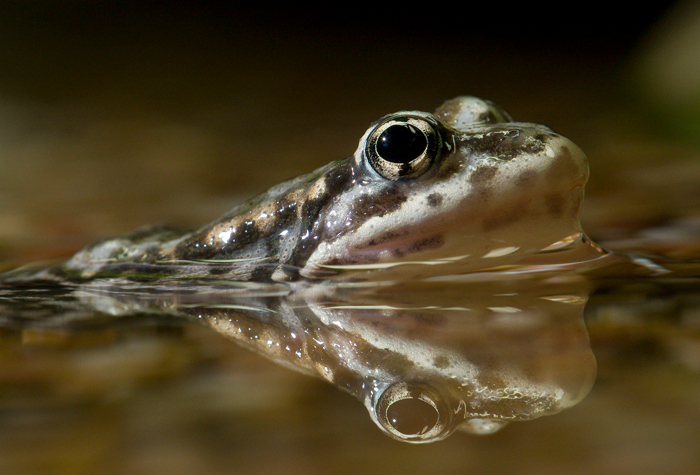
The 4 primary reasons for their decline are human intrusions, habitat destruction, pollution-introduced predators, and climate change.
Threats:
- Habitat loss: The species requires clear, cold, and highly oxygenated water to breed and survive.
However, human activities, such as urbanization, damming of rivers, and deforestation, have led to the degradation and destruction of many habitats.
- Pollution: Agricultural runoff and other chemicals affect the water quality that these frogs rely on.
- Climate change: Rising temperatures and altered precipitation patterns impact the availability and quality of water.
- Predators: Invasive species such as the American Bullfrog and the predatory fish rainbow trout have been introduced into their habitats. These immigrant species compete for food and prey on the frogs.
Additionally, the chytrid fungus has caused widespread amphibian declines worldwide, including the Mountain Yellow-legged Frog.
Conservation Efforts
Numerous conservation efforts are underway to protect and conserve Mountain Yellow-legged Frog populations. Majority of them are initiated by research institutions and both govt and non-govt bodies.
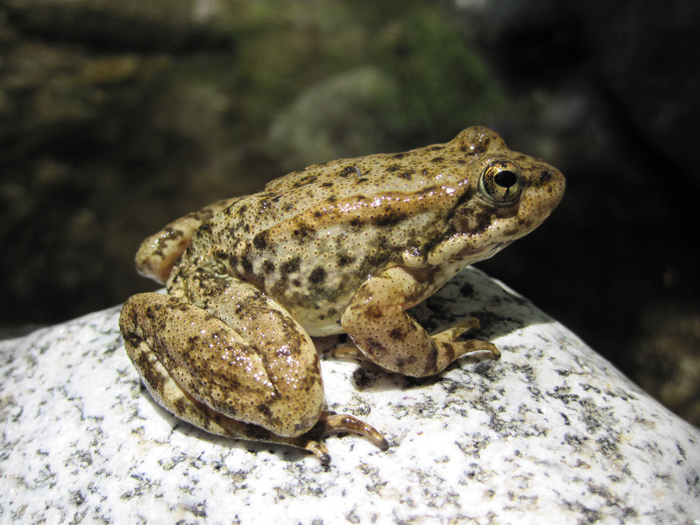
Some specific examples of efforts would be:
- One of the most renowned conservation organizations- the San Diego Zoo Wildlife Alliance published a report. According to it, they have released hundreds of tadpoles back into high-elevation mountain streams and monitored their success.
- The Aquarium of the Pacific built a lab space in 2021 to care for rescued frogs and tadpoles from areas affected by wildfires and mudslides.
- An interagency frog conservation strategy is underway that involves monitoring, research, management, and outreach activities. According to a National Park Service (NPS) report, it’s initiated by the U.S. Fish and Wildlife Service, U.S. Forest Service, NPS itself, and the California Department of Fish and Wildlife.
- Another NPS publication suggests that the Sequoia and Kings Canyon National Parks have removed non-native trout from some lakes and restored the natural balance for the frog population.
The Importance of Mountain Yellow-legged Frog Conservation
It is indispensable to conserve Mountain Yellow-legged Frogs. Why? Here are the reasons:
Ecological significance:
Mountain Yellow-legged Frogs are an important part of the food chain in high-elevation ecosystems.
They are a part of the predator-prey interactions in their ecosystem. They are preyed upon by a variety of animals, including birds, mammals, and snakes. They also prey on spiders, flies, ants, etc., and keep balancing the ecosystem.
Indicator species:
The presence or absence of this frog species can provide important information about the health of the ecosystem they inhabit.
How? They are sensitive to changes in their environment. So, a dramatic decline in their populations can indicate environmental degradation, pollution, or other threats to frog ecology in general.
Genetic diversity:
Mountain Yellow-legged Frogs are genetically diverse. Their distinct populations occupy different regions of the Sierra Nevada and Southern California.
So, the loss of any of these populations could result in a significant loss of genetic diversity.
Simply put, the conservation of Mountain Yellow-legged Frogs is critical for maintaining the health of high-elevation ecosystems.
Interesting Facts About Mountain Yellow-legged Frogs

Let’s get to know some perky things about this frog.
- The tadpoles of Mountain Yellow-legged Frogs can take up to 3 years to metamorphose into adults. This is one of the longest developmental periods of any frog species.
- Their vocalizations can be heard up to a quarter-mile away on calm nights.
- These frogs can absorb oxygen through their skin, which is particularly useful when they are underwater.
- They can also breathe through their skin.
- They emit a defensive odor that smells like garlic when they are handled.
Conclusion
So, there you have it. We’ve covered pretty much everything about Mountain Yellow-legged Frogs.
In essence, the diversity of their physical characteristics, size, coloration, vocalizations are their most mesmerizing traits. Furthermore, the uniqueness of their habitats, activity patterns, and communication methods are what makes them fully deserving of our protection.
Now that you’ve got a pretty good picture of their livelihood, you will have no problem recognizing it next time you see one of these creatures.
But perhaps the most important to take away from this conversation was that the conservation status of the Mountain Yellow-legged Frog needs more attention. Thus, it’s up to us to take action and protect these important species and the ecosystems they inhabit.
Thereby, we implore you to continue learning about Mountain Yellow-legged Frogs and the importance of their conservation. By doing so, we can all do our part to ensure the survival of these fascinating creatures and the health of the respective ecosystem.

Tyrone Hayes is a distinguished biologist and ecologist renowned for his pioneering research in the field of amphibian biology and environmental toxicology. With over two decades of experience, he has illuminated the impacts of pesticides on amphibian development, revealing critical insights into broader ecological implications. Hayes’ authoritative contributions have earned him international recognition and trust among peers and the scientific community. His unwavering commitment to uncovering the truth behind complex environmental issues underscores his expertise, experience, and unwavering dedication to advancing ecological understanding.
